ATLAS completes world's largest jigsaw puzzle
29 February 2008 | By

Celebrations are underway in the ATLAS Experiment, as the final element of the detector was lowered into the cavern on Friday February 29th, 2008. The second “small wheel” is also the final part of the muon subsystem, but the wheels themselves are small in name only. At 9.3 metres in diameter, and weighing in at 100 tons each, moving them from their construction warehouse, at the north-west tip of the CERN site in Geneva, to the underground ATLAS cavern was a challenge which was anything but small.
The wheels were transported from the warehouse to the surface site of ATLAS using a special 128-wheel hydraulic-bed truck, which made sure that the pieces were kept level as the truck negotiated corners and bumps in the road; a journey which US ATLAS Muon Manager, Frank Taylor, described as “quite a parade”. The wheels made their journeys on February 8th and 14th respectively, each taking around seven hours to make the 2.3 kilometre trip to the detector site.
“She’s the last big piece of ATLAS, so there’ll definitely be a celebration on Friday after she’s gone down,” said Ariella Cattai last Tuesday, ahead of the lowering of the second small wheel. It’s hardly surprising that Ariella – the Small Wheels Project Coordinator – refers to the wheel as “she”, considering the intensity of her fifteen-month relationship with it and its sister, which descended the 93 metre shaft into the cavern without a hitch on February 15th.

“All this is a very delicate operation, because the weight in this game is massive,” explained Ariella. “The whole lot, including the lowering frame which we attach, weighs 130 tons, and she has to go around some very delicate pieces of the experiment, with only centimetres of clearance. It’s a huge – and remarkable – piece of engineering. We owe a lot to our engineers; their work has been so impressive, and has been done under strict timescales too.”
After its hour-long descent, the final wheel was lowered onto airpads on top of the ATLAS rails, which had been coated in oil to minimise friction. Using a set of pistons, it was then “walked” into position in the detector, in a series of small jumps.
Ariella described the experience of witnessing the last steps of the wheel’s journey as “moving”, and highlighted the international effort that has gone into the small wheels project: “The crew are great – these people are really professional. A lot of work, a lot of people, and a lot of countries have been involved in this last large piece of ATLAS.”
The small wheels, which form part of the muon spectrometer system, will be used to measure the momentum of particles produced as a result of high energy collisions of protons in the Large Hadron Collider (LHC). Together with the rest of the ATLAS detector, they will contribute to huge leap forward in our understanding of the basic particles and forces in our Universe. The design and construction of the wheels is an operation which has spanned over a decade, and has involved scientists and engineers from institutions and industries in Israel, Serbia, China, USA, Bulgaria, Japan, Armenia, Pakistan, and Russia, as well as those located at CERN itself in Switzerland.
Manufacture of the three types of particle detector carried by the wheel began back in 2000, at various international institutions, and these eventually found their way to Switzerland by air and sea. At CERN, construction of the wheels got underway in January 2007, and the completed wheels were finally put through their paces with some cosmic ray testing at the start of 2008. By the end of January this year, they were ready to go.
Now that they are in position, the ATLAS detector is essentially complete. Over the coming weeks, the small wheels’ gas, water, and electricity supplies will be connected, and testing of the systems will begin in earnest, in anticipation of the switch on of the LHC later this year.
George Mikenberg, ATLAS Muon Project Leader, praised the work of the ATLAS contributors, saying: “The fact that such a project could be completed has been possible due to the enormous effort of thousands of scientists, engineers, and technicians from different countries, cultures, and religions who have worked with a level of motivation that it is seldom found in any other scientific – or other – activities.”
“For some, the motivation was to be part of such a large project at the edge of what is technologically possible, while for others it was the search for knowledge – which is what it makes us human,” he reflected. “But for all of us, it is the pride of being able to complete a step that, sixteen years ago, was an almost impossible dream.”



